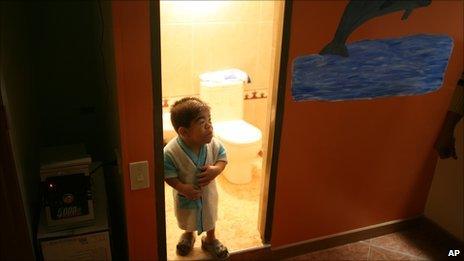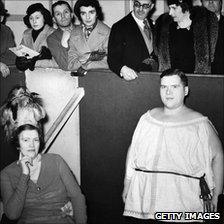Is it bad taste to have a 'world's shortest' record?
- Published

Edward Nino Hernandez said he was happy when he was the world's shortest man, "because I'm unique"
The world has a new "shortest woman" according to record keepers. But is documenting and publicising such a fact little better than staging an old-style circus freak show?
It's 125 years since police closed down the Whitechapel exhibition room where Joseph Merrick was put on public display.
"Ladies and gentlemen ... I would like to introduce Mr Joseph Merrick, the Elephant Man," went the showman's warm-up. "Before doing so I ask you please to prepare yourselves - Brace yourselves up to witness one who is probably the most remarkable human being ever to draw the breath of life."
The exhibition of remarkable human beings had been a form of popular entertainment since at least Samuel Pepys' time, but in late Victorian London the city authorities took a dim view of it, seeing it as a threat both to public morality and public order. It survived only in the fairground sideshow.
That it survives at all in the 21st Century is principally thanks to Guinness World Records.
The latest entrant in the "world's shortest" category is Indian Jyoti Amge.
Ms Amge measures 62.8cm (or 24.7 inches) and has a condition called achondroplasia, a form of dwarfism.
Like many of the title holders she is proud with the award.
"I feel grateful to be this size, after all if I weren't small and had not achieved these world records I might never have been able to visit Japan and Europe, and many other wonderful countries," she said.
Poor taste
But the Guinness publishers are like freak show hucksters, says Bob Bogdan, a professor in the Disability Studies department at Syracuse University.
"If someone is very small and it's a result of medical factors such as pituitary or thyroid disfunction, and possibly malnutrition, it's creepy to champion this," he says.
In his 1990 book, Freak Show, he quotes a colleague referring to the practice of "presenting human oddities for amusement and profit" (the book's subtitle) as the "pornography of disability".
It's not a phrase he would use himself. In the book he notes that the sideshows of old exhibited people in "demeaning ways, ways that promote fear and contempt" but also sometimes in ways "that positively enhanced their status".
But he does label it as "poor taste" and "low-grade popular culture".
So, how does Guinness World Records respond to this kind of criticism?
Editor-in-chief Craig Glenday says the book aims to encompass the "entire spectrum of life".
"By highlighting the extremes, we help you to put your position in the world in context; we define the outermost boundaries so you know exactly where you fit in," he says.
"One small part of our book - in the 2011 edition, for example, it's a mere 12 pages out of 288 - explores the extremes of the human body. This includes the tallest, the shortest, the heaviest, the hairiest and so on."
Chainsaw jugglers
"As the world becomes smaller, we are increasingly able to give a voice to those who are different or unique. By showcasing such characters in our book, we are announcing to the world that these people are as much a part of our world today as the sports stars, actors, scientists and chainsaw jugglers you'll find in the rest of the book."

Royal attraction: The ex-Queen of Spain visits a circus 'freak show' in London in 1938
A key point is that all the record holders celebrated in the book have chosen to be included. Guinness respects the wishes of people who do not want to be named in the book, he says, or included in the Guinness database, because "they don't wish to publicise their condition".
But is this enough?
When campaigners in London petitioned for her release, Saartje Baartman, a woman of South Africa's Khoi who was known as the "Hottentot Venus", testified in court she was being exhibited of her own free will.
Yet that was 200 years ago. Few would consider it acceptable today to put a naked African woman on display in Piccadilly, to allow the public to wonder at the size and shape of her buttocks. It would also now be scandalous to exhibit conjoined twins for money or hydrocephalic children, however willing they might be.
The philosopher AC Grayling was one of those who read the BBC News story about Edward Hernandez on Monday. He was not scandalised.
Squeamish fascination
"I was very curious about it," he says. "I clicked from there on to the story about the preceding shortest man, a Chinese chap, who was rather entertaining and cheered people up a lot. It's not clear to me that it's cruel or tasteless.
"If you were a tiny little short fellow, and made a living from being in the movies, how much difference is there between that and Naomi Campbell using her physical attributes to capture public attention?"
We have a natural curiosity about who can jump highest, or run fastest, he says. It's possible to have a similar healthy interest in who is the shortest or tallest.
The fact that doctors consider dwarfism pathological does not necessarily mean that wanting to read about the world's shortest person is a case of "horrid squeamish fascination", Prof Grayling argues - though he admits that the line between respectful and disrespectful attitudes is a narrow one.